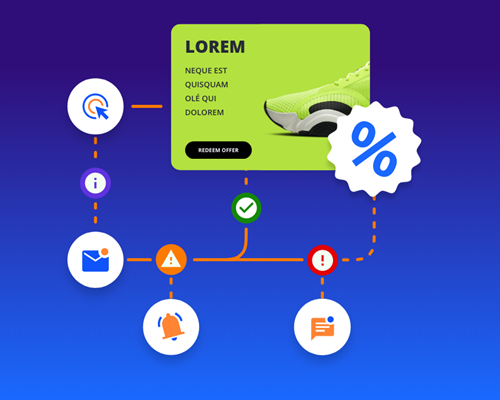Are you considering creative automation for the first time?
Encodify
5 min read

Here's everything you need to know about what it is and how it can help you.
Creative and marketing professionals are facing some of their steepest challenges yet; their services are in higher demand, but with budgets cut by 11% of revenue to 6.4% (Gartner) and tighter deadlines too. Whether your personal experience has been difficult, tiring, or even a total nightmare, you're no doubt looking for a solution.
Fortunately, there is one, and it's emerging rapidly: creative automation.
Uses of creative automation for modern marketing teams
Creative automation holds the answer to the challenges many marketing and creative professionals are facing. It's easy to implement and can greatly reduce the burden on you, your team and your budget.
You can use creative automation to:
- Create an overview of large volumes and versions of creative materials across channels and media types
- Automate the production of large volumes and multiple versions across languages and dimensions of your creative output
- Align your creative automation with your workflows to avoid the off-process trap (the cost associated with stand-alone systems)
Essentially, you’ll be freeing up your marketing talent’s time to do more of what you hired them to do — creating great content and campaigns — rather than resource-draining manual tasks.
Creative automation: Getting started
1. Identify your pain points
Look at where the pain points are in your operations. Where are the bottlenecks? What aspects of daily operations that’s prone to errors, taking up a lot of time, or wearing your team down with mental fatigue? Maybe your managers find themselves sending an email to the team every time they leave feedback on a visual asset that’s in production? Perhaps they’re spending valuable hours manually resizing visuals to share on different platforms?
These are all examples of tasks best left to automation. Creative automation can help with scheduling repetitive communications in advance or making accurate, error free adjustments to creative content faster at scale. Finding these solutions begins with knowing the problems.
2. Know your stakeholders
The buying process of any marketing technology system is often made in consensus amongst key decision makers. Who they are will depend on the organisation. They may include IT managers, marketing technology specialists, production leads, marketing heads or c-suite executives. Whoever your stakeholders are, collaborate with them when settling on a creative automation solution — there’s no need to involve them in every discussion, but ensure you know their needs. Without your stakeholders on board, you may end up investing in a tool that is actually more disruptive than it is effective.
Even when creative automation is implemented, look to also include those stakeholders who will maintain your automation system. These may be software teams, office staff, or you may prefer to hire a dedicated team member.
3. Use no-code solutions to allow smooth onboarding
Look for no-code solutions that will keep your creative automation as straightforward as possible. When you do this from the outset, you will minimise future challenges and avoid potential development costs. No-code, or even low-code, solutions means that the solution can be implemented quickly, through configuration and built to meet your requirements. This can be designed to fit in with your existing workflows and processes, that in turn reduce the load on your support team and free up more of their resources for other projects.
4. Integrate your marketing technology tools
Some creative automation tools integrate with the rest of your workflow, but others don’t. The creative automation solution you choose should fit in seamlessly with the other tools and platforms your team is using. If not, you risk using more resources and cost on software and not getting an efficient result.
Furthermore, effectiveness drops when you spend more time managing systems than benefitting from the solution. As seen in the diagram below, when your systems aren’t working together as part of an efficient process, they’re working off process and this can be seen as the 'off-process trap'.
An example pain point: When automation doesn't align with your workflow process

Automation effectiveness needs to be aligned with workflows for full effect
This is one example of a pain point that might be present in your current production processes. Maybe you have different marketing and automation systems such as proofing and approval management working in silos and not connected? Adding creative automation as another siloed solution isn’t going to help.
In this case, one campaign could have staff spending time tediously transferring information from one to the other - which takes up time and money. So save time and have all these systems connected and feeding into each other automatically. At Encodify, our approach is that we ensure all systems work together as part of the same process, or 'in-process', thereby reducing errors and time spent.
It’s here that Encodify really steps up. Ours isn’t just another tool in your tech stack, it’s an integrated part of a much larger workflow for marketing teams and creative agencies — it covers all steps of the process, from initial brief and content generation to quality assurance and beyond. We integrate with a broad range of other marketing technology solutions your team relies on, unlocking greater benefits and added efficiencies.
Reach out to our team today and for more information on how creative automation can help your creative team work better together, check out our guide ‘Tackling your production challenges with automation’.











